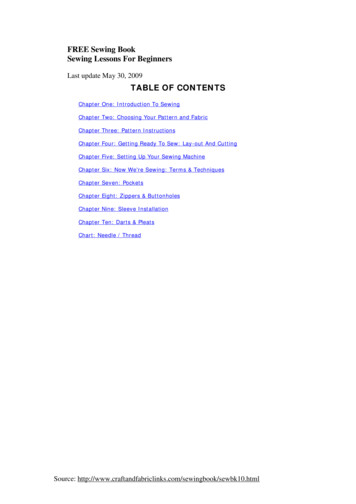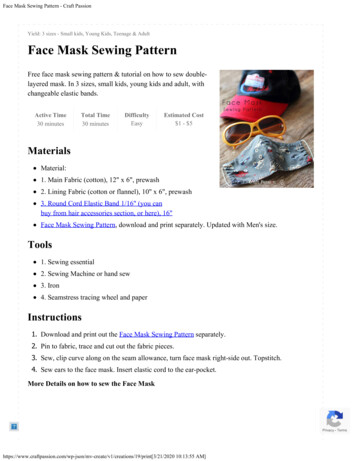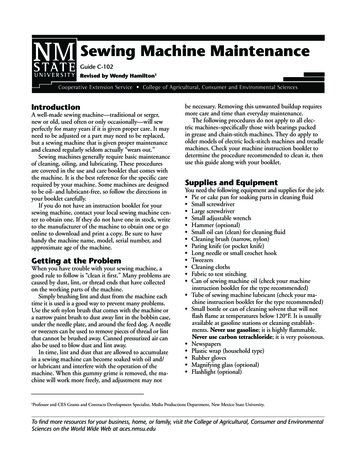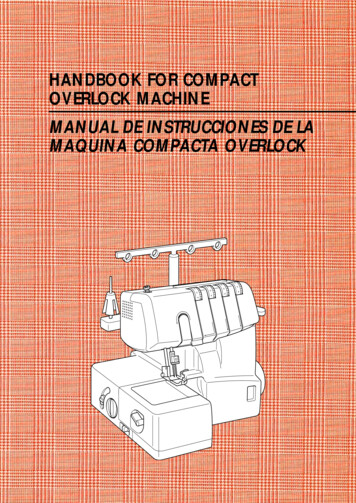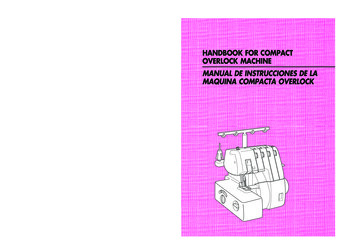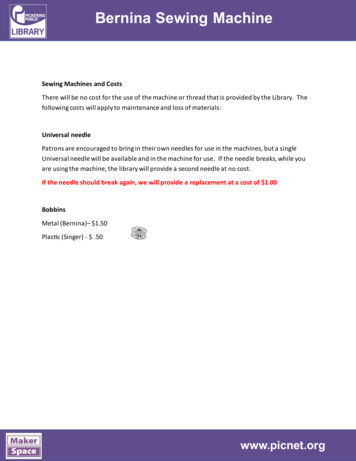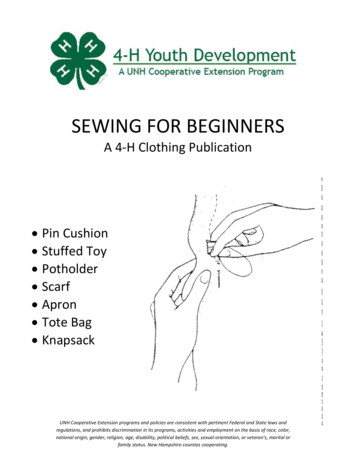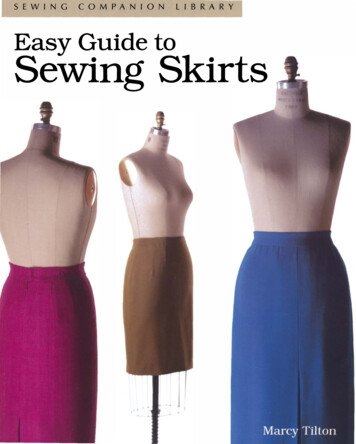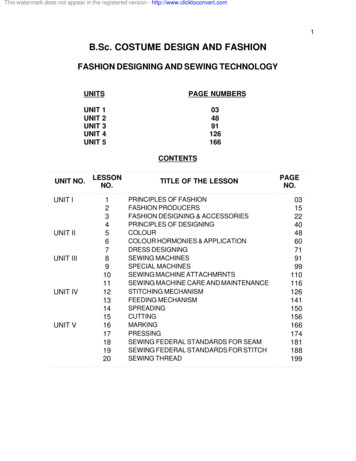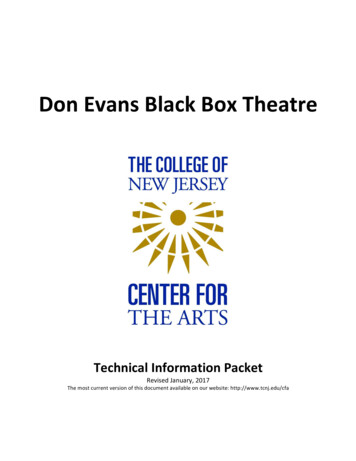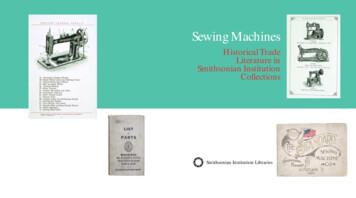
Transcription
Sewing MachinesHistorical TradeLiterature inSmithsonian InstitutionCollectionsSmithsonian Institution Libraries
Sewing MachinesHistorical TradeLiterature inSmithsonian InstitutionCollectionsA SMITHSONIAN INSTITUTION LIBRARIESPUBLICATIONWashington, DC2001
2001 Smithsonian InstitutionLibrary of Congress Cataloging-in-Publication DataSmithsonian Institution.Sewing machines : historical trade literature in Smithsonian Institution collections.p. cm.Includes bibliographical references and index.1. Sewing-machines—United States—History—Bibliography.2. Smithsonian Institution. Libraries—Catalogs.I. Smithsonian Institution. Libraries. II. Title.Z5853.M2 S55 2001016.026'6462044'0973—dc212001000621This booklet was prepared and published by the Smithsonian Institution LibrariesFunding for the design and printing of the booklet was provided by the Lemelson Centerfor the Study of Invention and Innovation, National Museum of American History,Behring Center, Smithsonian InstitutionDesign by Stephanie Firestone DesignPhotography by the Smithsonian Office of Imaging, Printing, and Photographic Services The paper used in this publication meets the minimum requirements of the American NationalStandard for Permanence of Paper for Printed Library Materials Z39.48-1984.Image identification. Cover: The Ross, Moyer Manufacturing Co.[n.d.]. Below, TheStandard Sewing Machine Co., (1895). Back cover: New Priscilla Sewing Machines.Priscilla Needlework Co. [n.d.]. Below, List of Parts. Singer Manufacturing Co. (1923).Title page: The Howe Sewing Machine Co. [n.d.], p. 12. Below: “The First PracticalSewing Machine – 1851.” Machine Sewing. A Treatise on the Care and Use of FamilySewing Machines and their Attachments. Singer Sewing Machine Co. (1938)
Sewing MachinesHistorical Trade Literature in Smithsonian Institution CollectionsCONTENTSiiForewordby Nancy E. Gwinniv“To the Trade ” The Trade Catalog Collection at theSmithsonian Institution Librariesby Rhoda S. RatnerviThe Textile Collection at the Smithsonian’s National Museum ofAmerican History, Behring Centerby Barbara Suit JanssenviiiThe Archives Center Collections at the Smithsonian’s NationalMuseum of American History, Behring Centerby John FlecknerixNotes on StylexAccess to the CollectionsxGlossary1Sewing Machines. Historical Trade Literature in SmithsonianInstitution Collections45Bibliographyby Barbara Suit Janssen47IndexManual of Athletic UnderwearManufacture. Union SpecialMachine Co. (1921), p. 33
ForewordThis guide illustrates the range of materials published by and about sewingmachine companies in the United States and other countries, starting in the1840s. Sewing machine catalogs and other industry materials are just oneportion of the remarkable collections of manufacturers’ trade literature heldin the libraries, archives and curatorial units of the Smithsonian Institution. The tradeliterature collection managed by the Smithsonian Institution Libraries (SIL) alonenumbers some 285,000 pieces published since the mid-nineteenth century andrepresenting 30,000 American companies. The Smithsonian Libraries is a 22-branchsystem serving the information and research needs of the Institution’s staff and thegeneral public.The Smithsonian collects trade literature for use by staff who are entrusted with thecare and study of manufactured objects now in the collections of the nationalmuseums. This guide to sewing machine literature includes materials held in threeseparate collections: in SIL’s Library in the National Museum of American History,Behring Center, and in the Museum’s Archives Center and in its Textiles Collection.The sewing machine project illustrates the collaborative efforts of Smithsonian staff toprovide relevant and useful information to the public as well as to the museum andresearch communities. This guide will be of interest to sewing machine collectors aswell as to historians, and the curatorial and program staff within the SmithsonianInstitution. We thank Barbara Suit Janssen of the Museum’s Textile Collection andJohn Fleckner, Director of the Museum’s Archives Center, for their cooperation withthis project. Ms. Janssen prepared the Bibliography that appears in the guide.A finding aid to these sewing machine literature collections including scannedimages of many of the texts can be viewed at /sewing-machines/. It is a work in progress which will continue to grow,providing extensive details about the three collections. The website will eventuallyprovide information on more than 3,000 items with many thousands of images. Fulldescriptions of each of the pieces of trade literature are given in the Libraries’ catalogat www.siris.si.edu (Smithsonian Institution Research Information System). Funding forthe scanning was provided by the Smithsonian Institution Image Archive Fund.The reader is cautioned to read the Notes on Style very carefully. The text of thisguide is based on information found on the pieces themselves and in availablepublished resources. This guide directs the reader only to materials which are in theSmithsonian collections.Many heads and hands contributed to this project, gathering the materials, sortingand classifying them, scanning and cataloging them, and preparing the text and indexin this printed guide. The project was conceptualized by Amy Begg DeGroff, ReferenceLibrarian in SIL’s American History Library, and she contributed her ideas and manyhours of work in organizing and describing the materials. Rhoda S. Ratner, head of theiiSewing Machines
History and Culture Department of the Libraries, and head of the American HistoryLibrary, completed coordination of the materials presented in this print guide.Nancy L. Matthews managed the production of this publication. In the Libraries’Information Systems Division, Martin R. Kalfatovic served as coordinator of theonline project. Courtney S. Danforth oversaw the online design process. InternsChristine Winkler and JohnLee Curtis and volunteer Betty Spungen assisted inassembling and describing the materials. Volunteer Kristina Santilla, a sewingmachine collector herself, helped with several stages of the project. Staff of theLibraries’ Preservation Services Department, headed by Susan R. Frampton, scannedthe images that can be seen online. David Holbert managed the production side ofthe scanning project, and Shawn Adams and Nicholas Worthy contributed to thatwork. In the Libraries’ Cataloging Services Department, Suzanne C. Pilsk coordinatedthe cataloging and metadata collection efforts. Other Libraries’ staff who contributedto the project are Maureen Daley who coordinated the photography for the printguide and Kari Richardson and Gwen Leighty who helped to prepare the fundingproposal to the Lemelson Fund. Mario Rups proofread the text and the index, andSavannah R. Schroll assisted with production responsibilities. This guide wasdesigned by Stephanie Firestone.We are grateful to the Jerome and Dorothy Lemelson Center for the Study ofInvention and Innovation for funds to publish this guide to a fascinating portion ofSmithsonian Institution collections.Nancy E. Gwinn, DirectorSmithsonian Institution LibrariesFebruary 2001Historical Trade Literature in Smithsonian Institution Collectionsiii
To the Trade The Trade Catalog Collection in the Smithsonian LibrariesIf you were to consider the words ‘book’ or ‘magazine,’ there are few among uswho would not have an image in mind of what these are. This is not necessarilytrue of the term ‘trade catalog,’ the name applied to commercial trade literature.As it is most often defined, the trade catalog is a multi-page listing ofmanufactured or produced items of any kind offered for sale by stock number orspecific name. These include sale and parts catalogs, technical manuals, companyhistories, instructions for using the product, testimonials from satisfied customers,pattern books, design books, price lists, and internal factory record books. The earliestcatalogs were directed ‘to the trade,’ meaning wholesalers and retailers. Today manytrade catalogs are published for the ultimate consumer as well as for the sales andrepair industries.The trade catalog developed as a result of and along with the industrial revolution.By the second half of the eighteenth century, the growing factory system enabledworkers to do twice to ten times the work of a single individual. Production rose,leading manufacturers to substantially increase their market territory to stimulatedemand. The trade catalog became a critical means by which the resulting demandwas met.Trade literature is a primary historical record of innovations in machinery andindustrial processes, in new techniques introduced for merchandising, and of othereconomic data relating to energy, manpower, and finance. The research value of thesecatalogs to the history of business, labor, and technology has only recently been fullyrecognized. The catalogs form both a by-product of and an index to industrializationand mass production.The range of research possible in these materials is enormous. A researcher cantrace a patent dream to reality. Outstanding authors and historians often wrote thecopy, and accomplished artists and engravers provided the woodcuts and lithographs.Manufactured objects, including products that no longer exist, are fully documentedas to size, materials, and operation, providing invaluable information to museumcuratorial staff and collectors. Illustrations of the workplace may display laborconditions or manufacturing procedures and perhaps the function of tools. The itemsoffered for sale are of special interest to those doing historical preservation orre-creations of interiors as indicators of cultural values and perceptions of status atthat time. The history of technology and industry as they evolved emerges from abroad study of this literature. Throughout, trade catalogs reveal the shift of theconsumer base from the privileged few to the general population, which productswere commercially successful and which disappeared from the market, and the spreadof innovations and techniques to different cities and regions.ivSewing Machines
Lawrence Romaine, a collector and dealer in trade catalogs, was the first todocument and champion the trade catalog in the United States. In his 1960 book,A Guide to American Trade Catalogs, 1744 – 1900, he wrote, “It is high time thatsomeone compiled and printed a record proving that Americans recognized the value ofadvertising catalogs and the mail order business even before they recognized the realvalue of freedom. There are ten thousand volumes that tell and retell the story of theAmerican Revolution. I offer one that will, without bloodshed, convince you of thecreative ability, imagination and Yankee ingenuity of the builders of this Republicthroughout the eighteenth and nineteenth centuries.”The Smithsonian Institution Libraries’ collection of historical trade catalogscontains over 285,000 items representing approximately 30,000 companies datingfrom both the nineteenth and twentieth centuries. It is the largest collection of its kindin the United States and encompasses the full range of products—from porcelaindinnerware to pipe fittings, seed catalogs to tractors, automobiles to medicalequipment. This is one more national treasure being protected, preserved, and madeaccessible by the Smithsonian Institution Libraries. It is our hope that this guide to onesmall segment of Smithsonian Institution Libraries’ trade literature collection will forma catalyst to others in the goals of preservation, access to researchers, and recognitionof a rich source for historical research.Rhoda S. RatnerHead, History and Culture DepartmentSmithsonian Institution LibrariesOctober 2000Historical Trade Literature in Smithsonian Institution Collectionsv
The Textile Collectionat the Smithsonian’s National Museum of American History, Behring CenterSewing machines, along with firearms, clocks, and agricultural machinery, playeda major role in developing nineteenth-century American industry. When historymuseums focus on the evolution of American technology, sewing machines serveas primary evidence in this study. Sewing machines were originally collected bySmithsonian Institution curators because of this importance to the early history oftechnology. Increasing interest in design, material culture, social and cultural history,economic history, labor history, technical communication, and advertising closelyrelates to the sewing machine industry and ensures that sewing machines will continueto be researched and explored.During the nineteenth century, the United States Patent Office Museum of Modelsexhibited models of patents that had been granted. Ultimately, the number of modelson display reached 150,000 and in 1926 Congress decided that the models shouldbe dispersed. The Smithsonian was given the first chance to select models for thenational collection, a responsibility shared by Museum curators Frederick Lewton andCarl Mitman. Fortunately for the Textile Collection, Lewton collected heavily in textilemanufacturing, particularly sewing machines.A major acquisition from the Singer Company in 1960 included many importantpatent models of sewing machines and attachments. Some recent accessions includeMrs. Tom Thumb’s sewing machine; Watson’s Family Sewing Machine, about 1850;an 1855 American Eagle Sewing Machine (cast in the shape of an eagle); and acollection of Singer Industrial Design Prototypes from the 1940s to the 1970s. TheNational Museum of American History sewing machine collection currently numbersapproximately 750 sewing machine patent models, 750 sewing machine attachmentmodels (tuckers, guides, buttonholers, etc.), and about 250 commercial, family, treadle,cabinet, electric, and toy sewing machines. The dates range from 1842 through 1976.Early research based on the Textile Collection of sewing machines and modelsbegan with The Servant in the House, written by Frederick Lewton in 1929. ThisSmithsonian Publication, reprinted in 1930 from the Smithsonian Annual Report,1929, pages 559-83, featured significant sewing machines and their inventors.Grace Rogers Cooper succeeded Lewton as curator and continued to collect sewingmachines. Cooper’s book, The Sewing Machine: Its Invention and Development,published in 1968, was revised and expanded in 1976. It is considered a classic in thefield. Along with the written history of the sewing machine are photographs of manyof the machines in the Collection and illustrations from various pieces of sewingmachine trade literature. In 1990 the exhibition catalog, Icons of Invention: AmericanPatent Models, edited by Barbara Suit Janssen, featured a chapter highlighting sewingmachines in the Collection.viSewing Machines
The Textile Collection of sewing machines has served other purposes as well.Over the years objects from the sewing machine collection have been exhibited inSmithsonian museums and in traveling exhibitions. Researchers—from high schoolparticipants in National History Day to academics working on their dissertations tosewing machine collectors—have published works based on the sewing machinecollection.One area of collecting that has grown greatly is that of trade literature. Cooper’s1976 book listed the holdings of the Textile Collection as consisting of thirty-twoadvertising leaflets, instruction booklets, flyers, and illustrated directions for threadingand operating sewing machines. Currently the Textile Collection of sewing machineliterature numbers more than 950. Researchers use the collection to enrich theirknowledge of commercial sewing machine manufacturing. Collectors use tradeliterature to learn how to thread machines, to know what parts are missing frommachines, and to understand operating instructions. Writers use illustrations from tradeliterature to picture a machine for which there may be no known surviving example.Finally, finding trade literature for a sewing machine about which little or nothing isknown often provides leads to the commercial history of the machine, its inventor, orits manufacturer.Barbara Suit JanssenMuseum Specialist, Textile CollectionNatural Museum of American History, Behring CenterOctober 2000Historical Trade Literature in Smithsonian Institution Collectionsvii
The Archives Center Collectionsat the Smithsonian’s National Museum of American History, Behring CenterThe Archives Center supports the mission of the National Museum ofAmerican History by preserving and providing access to documentaryevidence of America’s past. The Archives Center’s collections complementthe Museum’s artifacts and are used for scholarly research, exhibitions,journalism, documentary productions, school programs, and other research andeducational activities. We are delighted that information about the Archives Centermaterials related to sewing machines is reaching the public through the efforts of theSmithsonian Institution Libraries’ “Sewing Machines. Historical Trade Literature”project, both online and in this printed guide. The center holds two collections withsubstantial documentation of the history of the sewing machine.The Warshaw Collection of Business Americana was assembled by New Yorkbookseller Isadore Warshaw over a lifetime and sold to the Smithsonian Institution in1967. The Collection contains an extraordinary variety of commercially producedbusiness ephemera including advertisements, price lists, letterheads, receipts, tradecards, and trade catalogs. In total, the Collection occupies some 1,020 linear feet ofshelving and is organized into some 470 categories, primarily by type of product.Sewing machine-related materials, found in six document boxes and six over-sizefolders, are organized by name of manufacturer.The Singer Industrial Design Collection, 1927-1983, occupies some seventeen feet ofmaterials that show the influence of industrial design on Singer machines. Included arepresentation drawings, 1960-1983, by industrial designers such as Robert P. Gersin,Eliot Noyes, and Henry Dreyfuss and by designers from Singer’s in-house designdepartment. The Collection also includes Editorial Department product photographs,1927-1979, and examples of decals applied to Singer products.Many Center collections document entrepreneurial activity in which invention andmarketing are inextricably linked. The creation of nationally recognized brands andcorporate identities as well as commercial depictions of gender, ethnicity, and othercultural categories are well represented in the holdings. Some 700 Archives Centercollections occupy more than 9,500 feet of shelving in the American History buildingand in off-site storage locations. In addition to paper-based textual records, many Centercollections contain photographs, motion picture films, videotapes, and sound recordings.With few exceptions, Archives Center collections are acquired by donation, oftenin conjunction with the acquisition of related artifacts and in collaboration with theMuseum’s curatorial staff. Documentation projects—including oral and videohistories—actively create new research collections. The Museum’s ability to acquireand care for artifacts and archival materials in all physical formats and to generatecontemporary documentation gives it a unique capacity to record the complexity andrichness of the American experience.John FlecknerDirector, Archives CenterNational Museum of American History, Behring CenterOctober 2000viiiSewing Machines
Notes on StyleThis guide provides information about materials produced bythe American and foreign sewing machine industries, themanufacturers, the sales agents, and related industries. Thematerials themselves are held in three separate collections oftrade literature, all housed in the National Museum ofAmerican History (NMAH), Behring Center.Smithsonian Institution LibrariesThe Smithsonian Libraries’ sewing machine tradeliterature is part of a larger collection of over 285,000pieces of trade literature covering a wide variety ofindustries, businesses, and manufacturers from the late19th- to the mid-20th centuries in a number of fields oftechnology, the decorative arts, and seed catalogs. Thematerials are arranged in alphabetical order by companyname in the National Museum of American HistoryLibrary, one of twenty-two branches of the SmithsonianInstitution Libraries.Textiles Collection, Division of Social History, NationalMuseum of American History, Behring CenterThe Textile Collection’s sewing machine trade literaturehas been amassed over the years as specialists collectedand researched various sewing machines. The collectionincludes primarily trade catalogs, manuals, and fliers, andis arranged by company name.Archives Center, National Museum of American History,Behring CenterTrade literature is among the collections of the ArchivesCenter, NMAH. The Warshaw Collection of BusinessAmericana (c.1724-1975), a collection of advertisingephemera, includes materials generated by the Americansewing machine industry, such as: trade cards, invoices,bills, receipts, letterhead stationary, business cards, anddecals, dating from the early 18th to the late 20thcenturies. The materials are arranged in alphabeticalorder by the name of the manufacturer. The SingerIndustrial Design Collection, 1927-1983, includespresentation drawings, product photographs, andexamples of decals applied to Singer products.This guide is designed to provide information about thesewing machine materials in each collection. It is arrangedalphabetically by company name in a keyword in contextformat (KWIC).When known, the city of the company’s headquarters isnoted. In some instances, only the city of publication isavailable. This city name has been used followed by aquestion mark. Company names sometimes changed,occasionally adopting model names as company names, forexample. Wherever available, prior and subsequent companynames are included with caution to the researcher thatconfirmation of this information may require significantadditional research.Definitive dating is difficult to confirm for most of thesecompanies, so researchers are cautioned to consider thefollowing dates as representative. The determination for thedates of the companies’ operation has been guided byinformation in Grace Rogers Cooper, The Sewing Machine:Its Invention and Development (1976) and available dateson individual pieces. There are only four pieces in thecollection for Montgomery Ward, for example, so thosedates are used even though the company’s operation spannedmany years. In other instances, dates on correspondence andinvoices are used.Each company entry includes a table showing the typesand numbers of materials held followed by brief informationabout the company and its products.Historical Trade Literature in Smithsonian Institution Collectionsix
Access to the CollectionsThe National Museum of American History, Behring Center,is located on Constitution Avenue, NW (between 12th and14th streets) Washington, DC 20560. The National Museum of American History Libraryof the Smithsonian Libraries is open Monday-Friday,10:00 am to 5:00 pm, by appointment (202-357-2414).Email address: libmail@sil.si.edu The National Museum of American History,Behring Center, Textile Collection is open for researchMonday-Thursday, 10:00 am to 4:00 pm, by appointment(202-786-3100). The National Museum of American History,Behring Center, Archives Center is open for researchMonday, Tuesday, Thursday and Friday 10:00 am to5:00 pm; Wednesday noon to 5:00 pm, by appointment(202-357-3270; archivescenter@nmah.si.edu).Additional information is available Additional information about the Warshaw Collection is m. Internet AccessAn online finding aid to these sewing machine literaturecollections including scanned images of the texts can beviewed at:xGlossaryClippingsadvertisements and clippings from newspapersand booksCompany Materialscorrespondence, memorandums, invoices, andbusiness cardsDecalsintricate labels, designed to be affixed to asewing machineFliersone-page documents, often mailing inserts oradvertising piecesManualsinstructional booklets for a specific model or makeof sewing machineMapsinsurance descriptions and drawings developed byBarlow’s Insurance SurveysParts Listschiefly lists of parts, with or without images, oftenincluding current pricesStereoscopic Photographystereoscopic views of sewing machines in operationPicture Bookschild’s story book about sewing terature/sewing-machines/Postcardspicture postcards advertising sewing machinesIt is a work in progress which will continue to grow,providing extensive details about the three collections. Thewebsite will eventually provide information on more than3,000 items with many thousands of images. Fulldescriptions of each of the pieces of trade literature aregiven in the Libraries’ catalog at www.siris.si.edu(Smithsonian Institution Research Information System).Sheet Musicsheet music, with or without lyrics, relating tosewing machinesSewing MachinesTrade Cardscolorful and image-intense cards, distributed bysewing machine vendorsTrade Catalogsdetailed sales catalogs featuring model illustrations;descriptions of machines, often with prices;machine accessories and attachments
Sewing MachinesSheet MusicTradeCardsTradeCatalogsParts torical Trade Literature in Smithsonian Institution Collections1. Acme Buttonhole Attachment Company, Ltd.New York, New YorkNineteenth centuryThe Acme Buttonhole Attachment Company provided a sample of a nearly completebuttonhole made with its attachment on a trade card advertising the company.Archives Center12. C. G. Akam(Location unknown)1863-1889C. G. Akam traded with dealers and jobbers buying sewing machines in quantity.Textiles Collection13. American Bobbin Company(Location unknown)1902Patriotism prevailed for the American Bobbin Company. The company’s trademarkAmerican eagle was superimposed on an American flag decorating two bobbins.Archives Center14. American Buttonhole, Over-Seaming and Sewing Machine CompanyPhiladelphia, Pennsylvania1867-18931874: became the American Sewing Machine CompanyAmerican Buttonhole, Over-Seaming and Sewing Machine Company materials includeinvoices for machines purchased; fliers featuring calls for sewing machine agents in theNew England area; and trade catalogs featuring images of women in domestic settingsand in fashionable dress sitting at sewing machines.Textiles CollectionArchives Center2321No. 1 Primal ( 50); No. 2 Desirable ( 55);No. 3 Elegant ( 60); No. 4 Complete ( 65).Domestic Sewing Machine Co. [n.d.]Historical Trade Literature in Smithsonian Institution Collections1
Sheet MusicTradeCardsTradeCatalogsParts apsManualsFliersClippingsCompanyMaterialDecsals5. American Sewing Machine CompanyPhiladelphia, Pennsylvania1874-1888The American Sewing Machine Company materials include fliers advertising for skilledseamstresses; parts lists with pictures of sewing machines; and trade cards featuringtestimonials from owners of American Sewing Machine Company machines and pictures ofa young girl in a flower bed, clowns, and an ox pulling a wagon. One of the trade cardswas redeemable for entry in a drawing for a new sewing machine, courtesy of the company.Another trade card lists American Sewing Machine Company agents in Boston,Massachusetts.Textiles Collection1Archives Center321456. Avery Manufacturing CompanyBridgeport, Connecticut1875-18871888: Avery Sewing Machine, New York, New YorkAvery Manufacturing Company materials include trade cards which describe the Averymachine as the “best machine for agents to sell.”Archives Center17. Samuel Barker and Thomas WhiteBrattleboro, Vermont1858-1861The Brattleboro sewing machine produced by Samuel Barker and Thomas White was apatented single-thread family machine.Textiles Collection18. Bartholf Sewing Machine CompanyNew York, New York1850-1865A wholesale clothing company provided two testimonials describing the usefulness of andtheir satisfaction with the Bartholf machine.Archives Center19. Bartlett Sewing Machine CompanyNew York, New York1870-18761866-1870: Goodspeed & Wyman, Wichendon, MassachusettsThe Bartlett Sewing Machine Company featured pictures of sewing machines powered byhand and foot.Textiles Collection2Sewing Machines12
Sheet MusicTradeCardsTradeCatalogsParts apsManualsFliersClippingsCompanyMaterialDecsals10. A. H. Beebe and Company(Location unknown)1869- 1876A. H. Beebe and Company manuals featured instructions for installing and using itsRose’s embroidery needle attachment.Textiles Collection111. L. Philip BeersNew York, New YorkNineteenth centuryThe L. Philip Beers sewing machine could “hem, bind and cord without basting and willnot cause machine work to ravel.” The machine was awarded “first premiums” over othercompetitors for its general adaptation to all kinds of work in Europe and America.Archives Center112. F. O. BergSpokane, Washington1902An F.O. Berg trade catalog illustrates its improved pulling device shown as attached to aUnion Special sewing machine.Textiles Collection113. BerninaSwitzerland1966-The Bernina Sewing Machine Company collection includes trade catalogs and instructionsfor specific models with possibilities for stitchwork and decorative techniques.Textiles Collection471411914. Blees Sewing Machine CompanyBordentown, New Jersey1870-1873Howard and Hyde were general agents for the Blees sewing machine salesrooms at01 Central Street, Lowell, Massachusetts.Archives Center115. C. M. BolandNew York, New YorkNineteenth centuryThe C. M. Boland sewing machine for furs was patented in 1878 and the companyad
in the libraries, archives and curatorial units of the Smithsonian Institution. The trade literature collection managed by the Smithsonian Institution Libraries (SIL) alone numbers some 285,000 pieces published since the mid-nineteenth century and representing 30,000 American companies.

